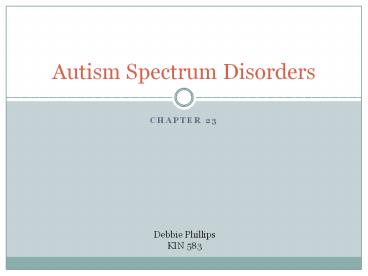Autism Spectrum Disorders - PowerPoint PPT Presentation
1 / 21
Title:
Autism Spectrum Disorders
Description:
Autism Spectrum Disorders Childhood Disintegrative Disorder CDD is a very rare condition All aspects of the development are typical until 3 to 5 years. – PowerPoint PPT presentation
Number of Views:394
Avg rating:3.0/5.0
Title: Autism Spectrum Disorders
1
Autism Spectrum Disorders
- Chapter 23
Debbie Phillips KIN 583
2
Autism Spectrum Disorder
- Neurodevelopmental Disorder Characterized by an
impairment in - Social Reciprocity
- A typical Communication
- Repetitive Behavior
- Disorder categories occur along a continuum.
- Synonym for the category is PDD Pervasive
Development Disorder.
3
Autism Spectrum Disorder
- The symptoms of Autism Spectrum Disorders
- Neurologically Based
- Scientific evidence of genetic pre-disposition
- Also likely to be gene-environment interactions
4
Autism Spectrum Disorder
- Diagnostic categories within the Autism Spectrum.
These are defined by the presence or absence
of behaviors in the following areas - Social Reciprocity
- Communication
- Repetitive behaviors
5
Autism Spectrum Disorder
- Autistic Disorder
- Autism is a discrete diagnosis within the ADS.
- Defined by a pattern of six symptoms distributed
across three areas. - At least two symptoms must be in the area of
social reciprocity. - See Table on following slide.
6
Autism Spectrum Disorders
- Diagnostic Criteria for Autistic Disorder
7
Autism Spectrum Disorders
- Aspergers
- Dr. Hans Asperger observed children with typical
language who had difficulty with socialization
and repetitive behaviors. - Diagnosed if three symptoms - 2 related to Social
Reciprocity and one to habitual behaviors are
present. - Considerable overlap between diagnosis of high
functioning Autism and Aspergers disorder. - Children with Aspergers disorder may not be
diagnosed until school age.
8
Autism Spectrum Disorder
- Pervasive Development Disorder Not otherwise
specified. (PDD-NOS) - Used to describe children who do not have the
number of distributions of symptoms for another
diagnosis within the ASD. - Fewer symptoms of autism are present.
9
Autism Spectrum Disorders
- Childhood Disintegrative Disorder
- CDD is a very rare condition
- All aspects of the development are typical until
3 to 5 years. - At this age all domains begin to regress
(language, cognitive ability, play, motor skills,
bowel and bladder skill deteriorate) - Represents a common final pathway for a number of
neurologic insults.
10
Autism Spectrum Disorders
- Retts Disorder/Syndrome
- Involves the loss of previously obtained language
and social milestones. - Associated with mutation in methyl-CpG- binding
protein 2 and a gene on the X chromosome. - Mostly see in Girls
- Affected children lose language and social
interest.
11
Autism Spectrum Disorders
- Diagnostic Features of Autism Spectrum Disorders
- Core symptoms are divided into three areas
- Qualitative- Impairments in Social Reciprocity.
- Atypical Communication Development
- Atypical Behavior
12
Autism Spectrum Disorders
- Causes of Autism Spectrum Disorders.
- The Genetics of Autism
- Family and Twin Study
- Candidate Gene Studies
- Association with Genetic Disorders of know
Etiology (genetic disorders) - Brain Structure and Function in Autism Spectrum
Disorders
13
Autism Spectrum Disorders
- Causes of Autism Spectrum Disorders Cont.
- Obstetric Complications studies have not
strongly shown any specific prenatal or birth
complications with the development of ASD. - Environmental Exposures
- Teratogen substances that result in birth
defects maternal medications, drugs of abuse,
chemical and radiation. - Vaccinations significant controversy
- Infections Prenatal infections increase the
risk
14
Autism Spectrum Disorders
- Gender and Autism Spectrum Disorders.
- There is a 41 male to female predominance of
ASD.
15
Autism Spectrum Disorders
- Early Identifications of Autism Spectrum
Disorders. - Symptoms must be present by 3 years of age.
- Delayed language development, repetitive
behaviors and atypical social responsivity are
common parental concerns. - Early diagnosis is based on the recognition of
the core features of ASD as they appear in early
childhood. - Atypical development of pretend play, pointing
to share interest, use of eye gaze to engage
another person in communication and social
interest. (as young as 18 months).
16
Autism Spectrum Disorders
- Evaluation of the Child with ASD.
- Multidisciplinary Assessment
- Diagnostic Measures
- Laboratory Testing
17
Autism Spectrum Disorders
- Associated conditions ASD may be associated
with intellectual disabilities and other
conditions. - Intellectual Disabilities ¾ have intellectual
disability - Learning Disabilities Specific impairment in
executive function - Epilepsy about ¼ with ASD
- Tic Disorders Up to 9
18
Autism Spectrum Disorders
- Associated conditions Cont.
- Sleep Disorders 50 to 70
- Gastrointestinal Symptoms Increase in pain,
reflux, diarrhea, constipation and bloating. - Psychiatric Conditions greater risk for
depression, mood disorders, ADD and anxiety.
19
Autism Spectrum Disorders
- Genetic Disorders with Autism Spectrum Disorders
- Tuberous Sclerosis
- Fragile X syndrome
- Chromosome 15 Deletion
20
Autism Spectrum Disorders
- Treatment Approaches
- Educational
- TEACCH
- Applied Behavior Analysis
- Developmental-Individual Difference-Relationship
Base model - Relationship Development Intervention
- Classroom-Based Programs
21
Autism Spectrum Disorders
- Behavioral Intervention
- Pragmatic Language and Social Skills Training
- Medication
- Stimulant Medications
- Selective Serotonin reuptake Inhibitors
- Atypical Neuroleptics
- Mood Stabilizers































